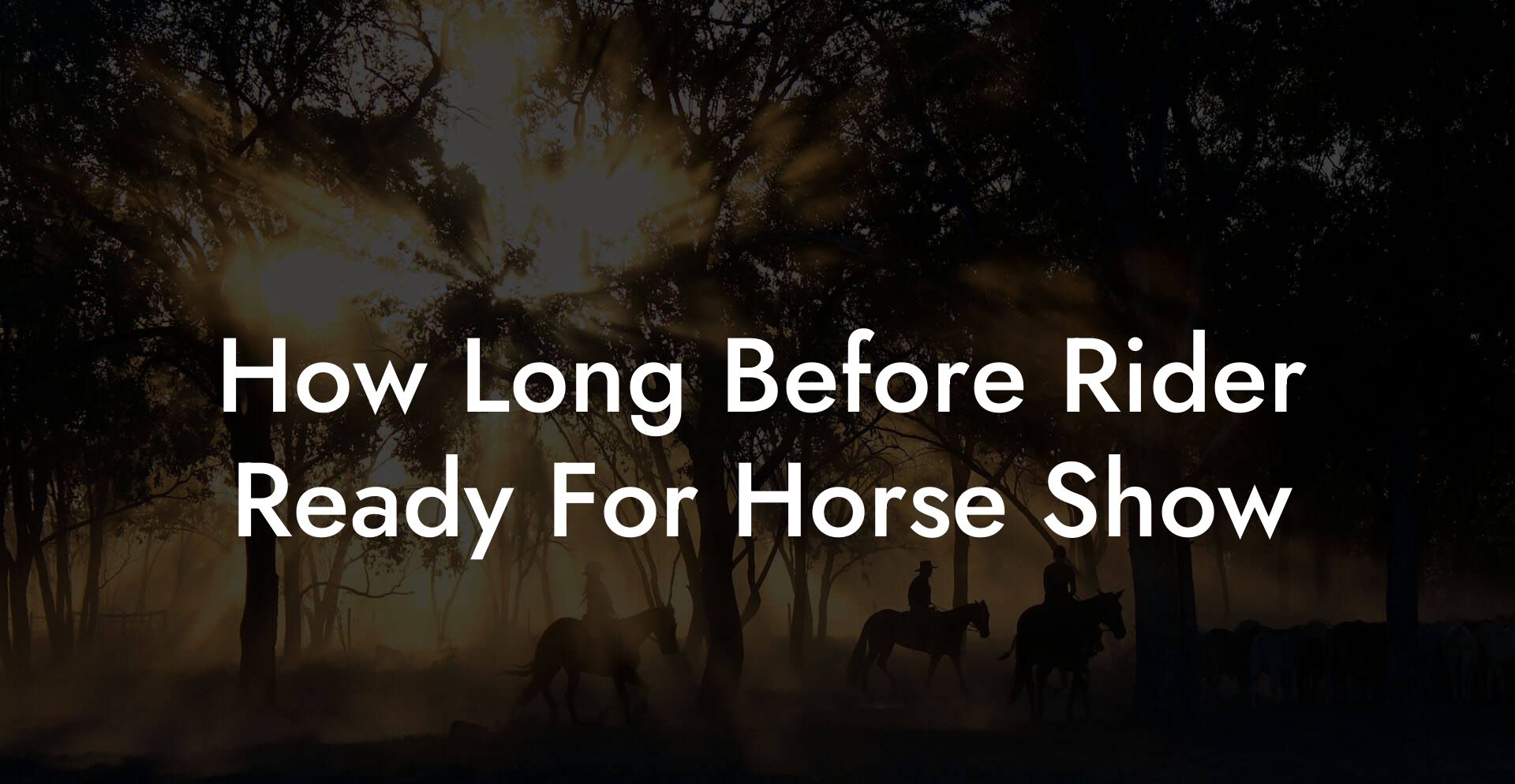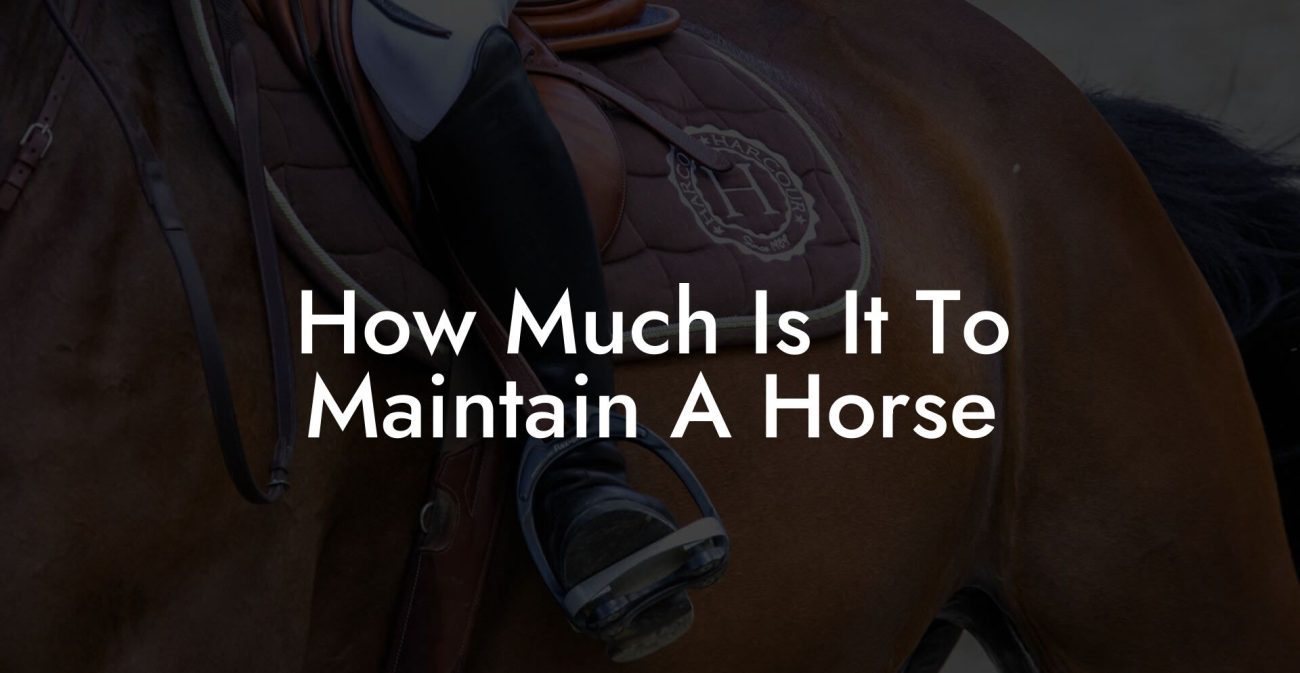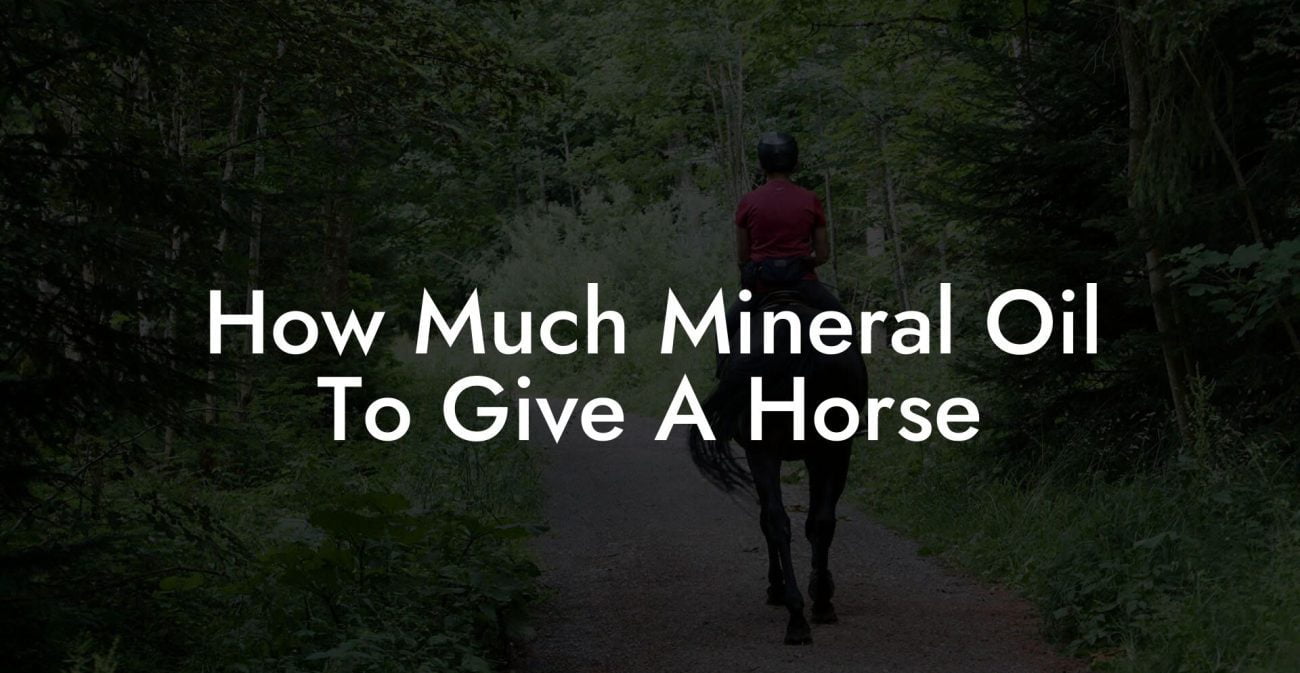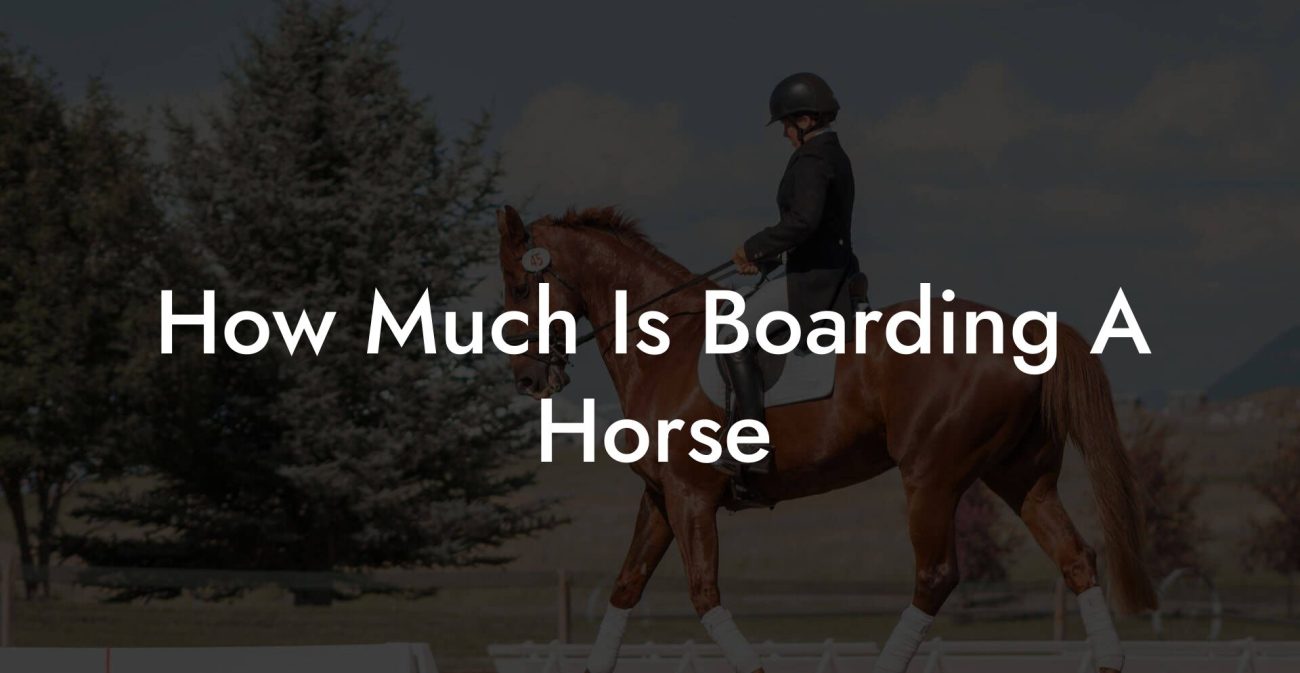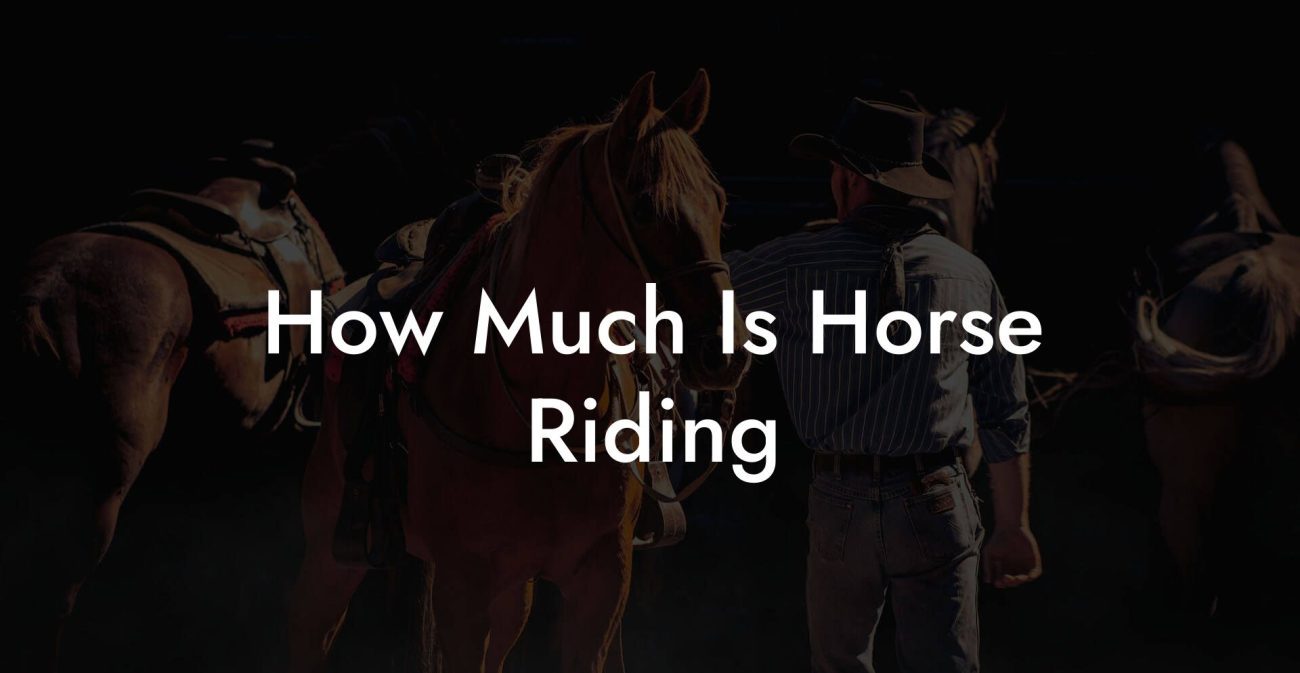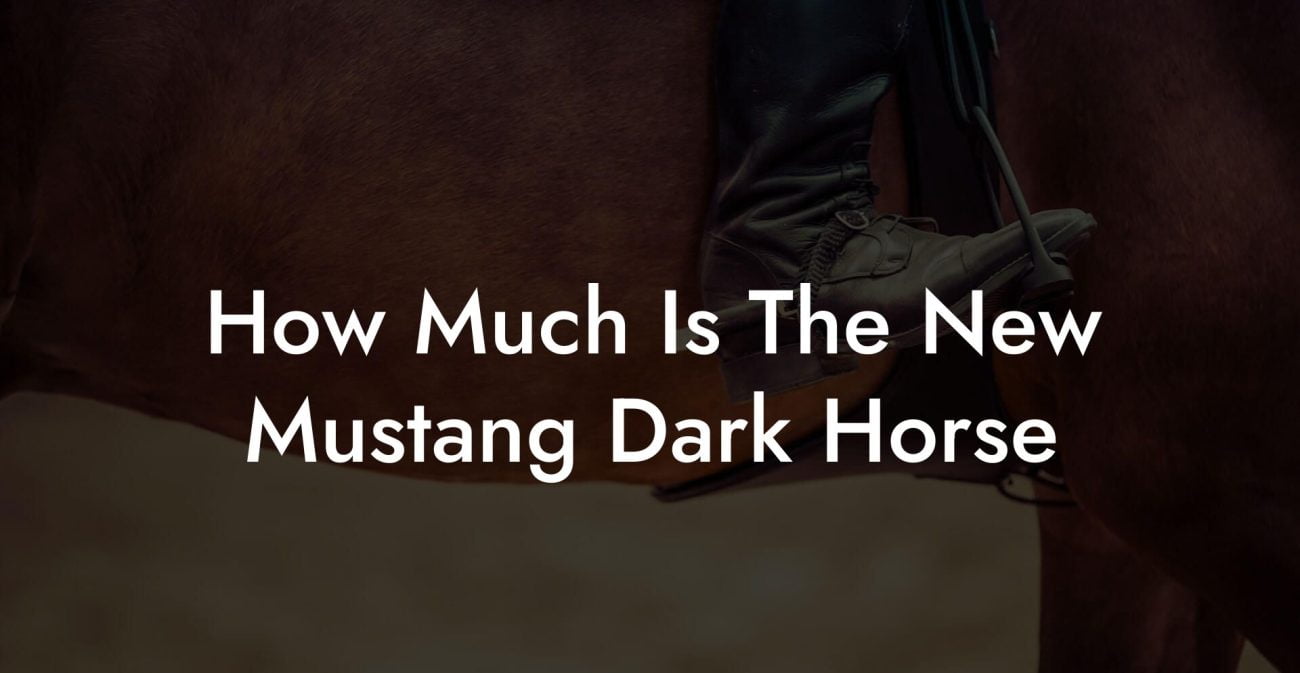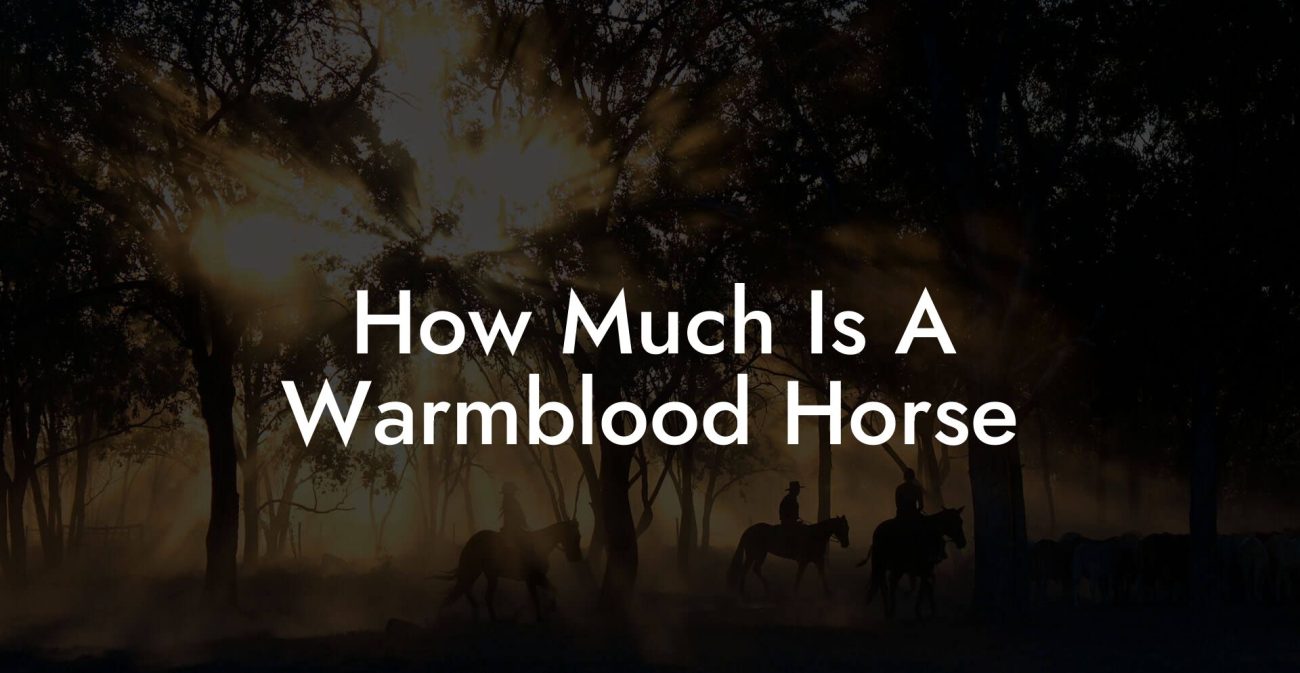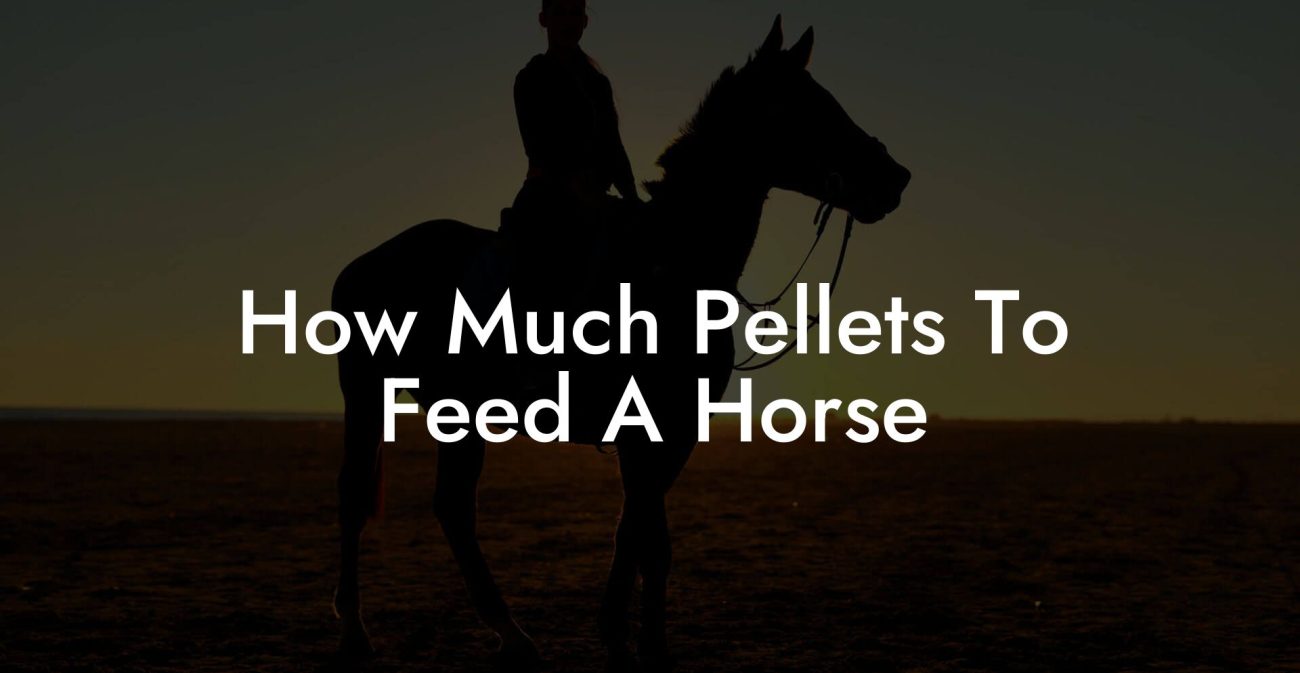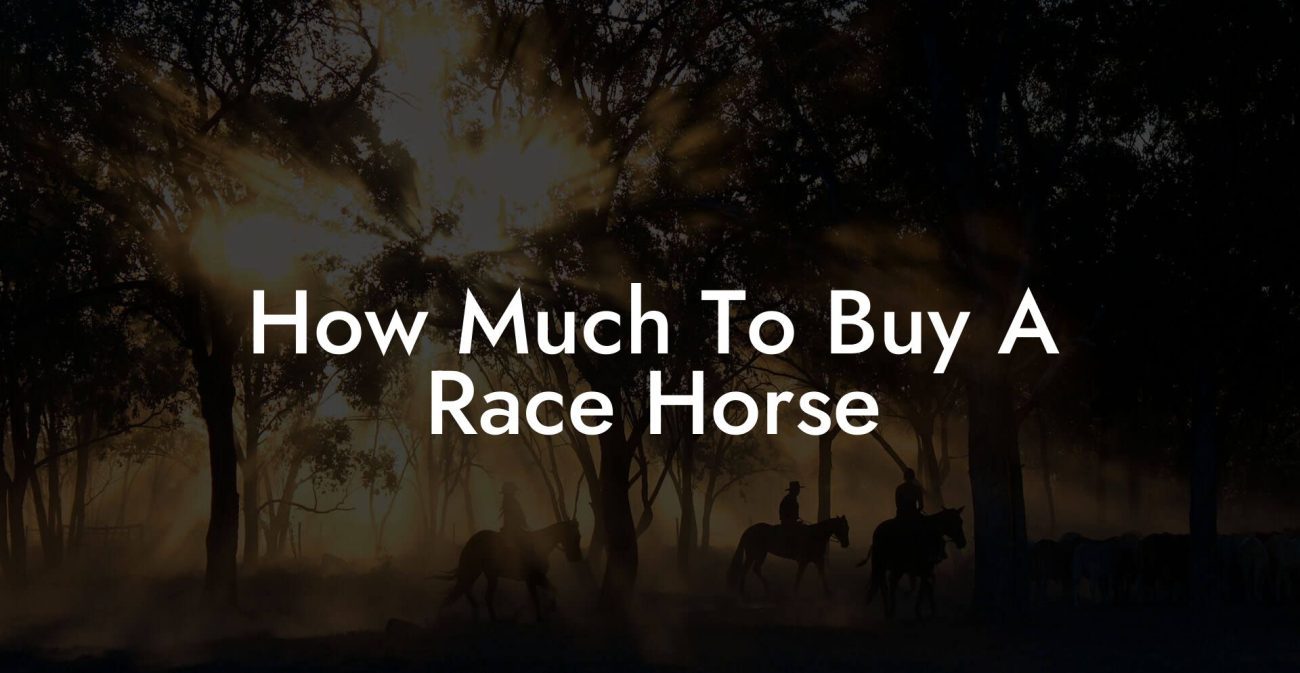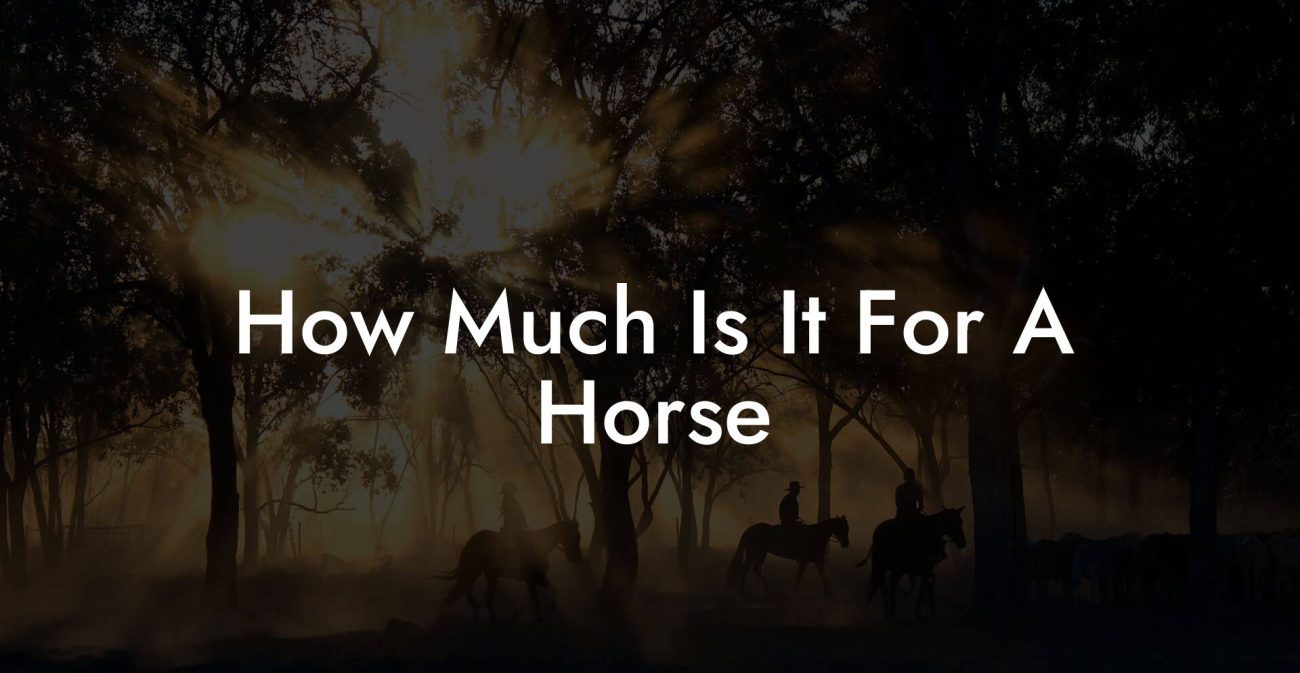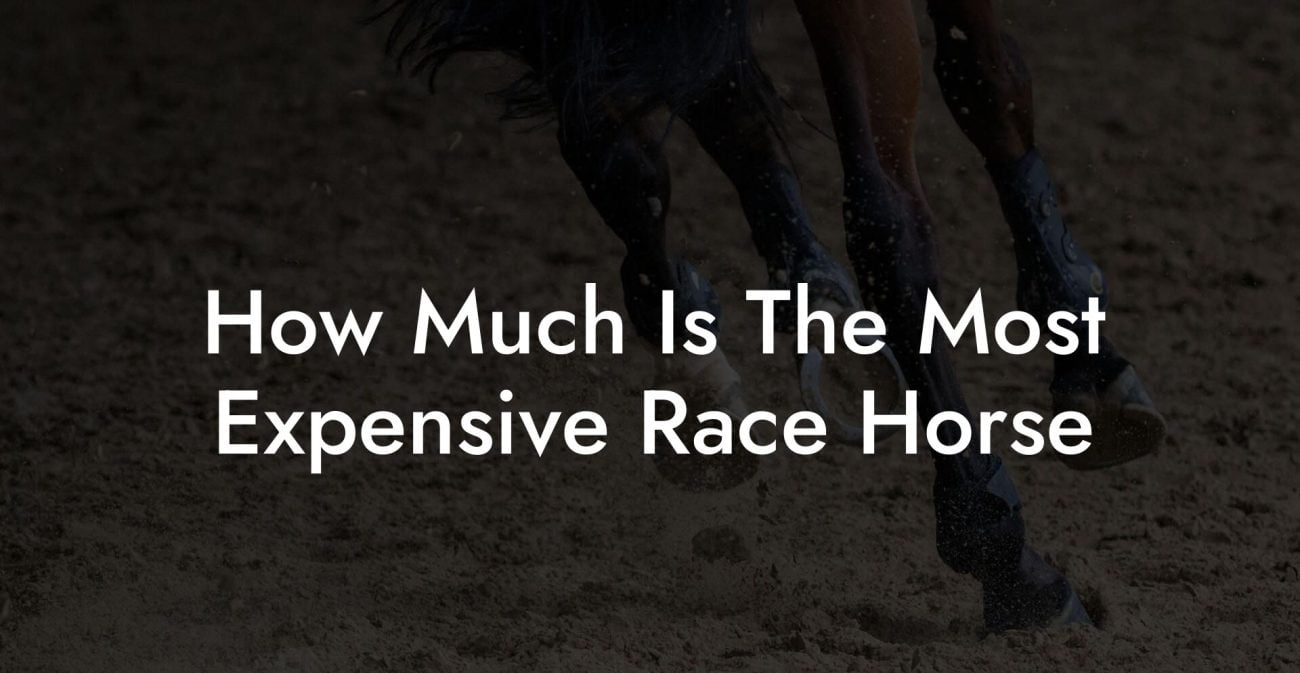Ever wondered how long it really takes for you and your equine partner to be show-ready? Whether you’re a budding rider with dreams of dazzling the arena or a seasoned equestrian looking for fresh insights, this guide dives deep into the timeline, tips, and techniques that transform everyday practice into show-stopping performance. We’re not just talking about a few weeks of rehearsals, we’re exploring the holistic approach to grooming, conditioning, and building that unstoppable rider-horse bond that propels you both into the spotlight.
Quick Links to Useful Sections
- Decoding the Timeline: How Long Before a Rider Is Ready for the Horse Show?
- Mapping Out the Journey: Key Factors in Rider and Horse Readiness
- Riding Skills: The Bedrock of Show Confidence
- Horse Conditioning: Building a Show-Ready Athlete
- Mental Preparation: Sharpening the Rider’s Edge
- Training Regimen: Structuring the Path to Perfection
- Weekly Structure
- Monthly Goals and Milestones
- Equine & Rider Synergy: The Ultimate Partnership
- Gear and Grooming: Essential Preparations for the Big Day
- Mastering the Show Day Ritual: From Check-In to the Arena
- Expert Recommendations: What Seasoned Trainers Say
- Tracking Progress and Adjusting Your Training Plan
- Resources and Community Support: Your Next Steps
- The Roadmap to a Successful Horse Show: A Step-by-Step Guide
- Step 1: Evaluate Your Baseline
- Step 2: Define Show Goals
- Step 3: Customize Your Training Plan
- Step 4: Implement Consistent Practices
- Step 5: Prepare for the Show
- Step 6: Re-evaluate Post-Show
- Riders’ Success Stories: Real-Life Transformations
- Case Study 1: From Cowboy Boots to Show Winner
- Case Study 2: The Perfect Partnership
- Case Study 3: Overcoming the Odds
- Integrative Horse Show Strategies: Embracing Modern Trends
- Integrative and Holistic Approaches FAQs: Your Questions Answered
- Your Journey to the Show Ring: A New Era of Equestrian Excellence
Decoding the Timeline: How Long Before a Rider Is Ready for the Horse Show?
The answer to “How long before rider ready for horse show?” isn’t a one-size-fits-all. It depends on a combination of factors including your current riding skills, your horse’s condition, training intensity, and the complexity of the show classes you plan to enter. For some, it might be a few months of dedicated, structured training; for others, a year or longer may be the magic number to ensure your horse and you shine on the big day.
With rapid shifts in the equestrian world and a community of passionate riders eager to blend modern techniques with traditional riding wisdom, understanding the readiness timeline means embracing both art and science. Today, we explore the various components, from physical conditioning and mental preparation to equipment optimization, that pave the route from the stable to the show ring.
Mapping Out the Journey: Key Factors in Rider and Horse Readiness
Getting ready for a horse show is a multifaceted process that hinges on a variety of elements. Let’s break down the core factors that determine how long the journey might take:
- Skill Proficiency: Developing refined riding skills including balance, coordination, and effective communication with your horse is paramount. Mastery of basic moves, transitions, and patterns forms the foundation of show readiness.
- Conditioning and Fitness: Both rider and horse require physical fitness. For riders, this involves core strength, flexibility, and stamina. Horse conditioning entails a balanced diet, regular exercise, and overall physical care that ensures endurance and agility during a performance.
- Training Regimen: The intensity and regularity of training sessions influence the timeline. Consistent practice, increasing complexity gradually, helps both animal and human build the muscle memory necessary for smooth show routines.
- Mental Focus and Confidence: The mind plays a crucial role in show performance. Confidence, reduced anxiety, and mental agility directly impact how well you and your horse perform under pressure.
- Horse health and Grooming: A healthy, happy horse is a show horse. Regular vet checks, proper grooming, dental care, and hoof maintenance are integral to ensuring your horse is physically ready.
- Pre-show Preparation: Everything from tack selection and rider outfit coordination to the final tune-up of your training protocol adds to the broader timeline.
Each of these factors not only influences the actual length of time before you’re show-ready but also highlights where you may need to invest extra effort. Balancing these aspects is key to a flawless debut.
Riding Skills: The Bedrock of Show Confidence
For riders, impeccable technique and confidence are non-negotiable when stepping onto the show arena. Young and dynamic Gen-Z and millennial riders know that blending traditional riding knowledge with modern training technology gives them an edge.
Building proficiency involves:
- Basics and Beyond: Perfecting basic riding postures, rein control, and seat stability.
- Advanced Maneuvers: Learning intricate patterns, controlled fast transitions, and nuanced cues that reflect advanced skill.
- Feedback and Analysis: Video recording your sessions, using rider simulators, and getting professional coaching for detailed critiques.
A robust training routine might start with an assessment of your current riding ability and then progress to targeted sessions focusing on areas like balance drills, lateral movements, and combination maneuvers. Consistent practice, often short but frequent, creates a muscle memory system that lets you ride with both precision and natural fluidity.
Horse Conditioning: Building a Show-Ready Athlete
Just as athletes train for the Olympics, your horse needs a customized regimen to achieve peak performance. Conditioning isn’t isolated to physical workouts; it’s an all-encompassing plan that looks at nutrition, mental well-being, and even the social aspects of your horse’s daily life.
A well-rounded conditioning program includes:
- Cardiovascular Fitness: Incorporating interval training, mixing canters with jogging sessions, and gradually increasing duration.
- Strength Building: Activities like hill work, arena drills, and targeted exercises to build muscle tone and balance.
- Flexibility and Balance: Stretching routines and exercises designed to improve suppleness, akin to a human yoga session, help keep your horse agile.
- Nutrition and Hydration: A balanced diet rich in essential nutrients along with optimized hydration schedules ensures quick recovery and endurance.
- Preventive Health Measures: Routine veterinary check-ups, deworming schedules, hoof care, and immunizations prevent underlying issues that could derail training progress.
Implementing these practices early on creates a reliable baseline that holds up even during the most competitive events.
Mental Preparation: Sharpening the Rider’s Edge
It’s not all physical strength and stamina, your mental game is key. Modern riders understand that mental preparation can be as influential as hours spent in the saddle. Staying calm, focused, and adaptable in the midst of chaos sets you apart.
Techniques to boost your mental readiness include:
- Meditation and Mindfulness: Regular meditation sessions reduce pre-show jitters and enhance focus.
- Visualization: Practicing mental run-throughs of your routines, from the moment you enter the arena to executing each maneuver flawlessly, primes your brain for peak performance.
- Confidence Building Exercises: Engaging in drills that push you out of the comfort zone gradually builds self-assurance. Positive affirmations, goal setting, and reviewing past successes are all part of this toolkit.
- Stress Management: Techniques such as deep breathing, progressive muscle relaxation, or even a quick bike ride before training sessions help reduce overall anxiety levels.
Incorporating these mental practices can mean the difference between a stumble and a graceful performance. The more in tune you become with your mental state, the smoother the communication between you and your horse.
Training Regimen: Structuring the Path to Perfection
A well-structured training plan is the backbone of show readiness. To transform a good rider-horse team into a stellar duo, both must follow a routine that addresses skill refinement, physical conditioning, and strategic preparation.
Here are some elements of an effective training schedule:
Weekly Structure
A typical week may be divided between focused riding sessions, conditioning days, recovery, and occasional breaks to prevent burnout. For instance:
- Monday and Wednesday: Intense riding sessions focusing on advanced maneuvers, pattern training, and real-time feedback through video reviews.
- Tuesday and Thursday: Conditioning workouts for the horse combined with core stability and balance training for the rider. These sessions might include hill work or controlled canter work to boost stamina and muscle strength.
- Friday: A combined session that integrates both skill drills and physical conditioning in a more relaxed, low-pressure setting.
- Weekend: Active recovery days. Light jogging, stretching, or even a leisure ride in the countryside helps both rider and horse recuperate, ensuring a balanced regimen.
Monthly Goals and Milestones
Apart from weekly workouts, setting monthly targets can help track progress. This might include mastering a new maneuver, increasing your horse’s endurance, or even optimizing your tack for better performance.
Regular evaluations with trainers can fine-tune your milestones. These check-ins not only provide accountability but also help recalibrate your training as needed. Remember, progress in equestrian sports is an evolving journey, and your training plan should be as flexible as it is focused.
Equine & Rider Synergy: The Ultimate Partnership
What truly sets rally-winning teams apart is the seamless connection between rider and horse. This bond isn't achieved overnight, it is a product of countless hours spent building trust, understanding subtle cues, and perfecting timing.
To foster this synergy:
- Consistent Communication: Learn to read your horse’s body language. Their small signals, whether a twitch of the ear or a change in posture, can speak volumes about their comfort and readiness.
- Mutual Trust: Build trust by being gentle but firm. Consistent, positive interactions during training sessions and everyday care help cement a deep sense of security.
- Joint Problem Solving: Tackle challenges together. Whether it’s a stubborn gait or a tricky maneuver, working as a team reinforces your partnership.
- Celebrating Small Wins: Every improvement, no matter how minor, is a step forward. Reward your horse with soothing pats or a favorite treat to cultivate a supportive training environment.
A well-synchronized rider-horse pair not only performs better in the arena but also creates a safety net during high-pressure moments. This subtle balance of respect, trust, and mutual understanding can only be developed over time, making it one of the most crucial investments on your journey to show success.
Gear and Grooming: Essential Preparations for the Big Day
Beyond the rigorous training and health protocols, there’s a world of gear and grooming that plays a pivotal role in the show ring. Both rider and horse need to look as sharp as they perform.
Rider Gear: Modern riders are all about combining functionality with style, think sleek helmets, ergonomic riding boots, and attire that reflects a youthful, bold flair. Ensure your gear not only meets safety standards but also supports your movement, providing ease during maneuvers and stable posture.
Horse Grooming: A show-ready horse is more than just fit, its coat shines, mane is neatly braided, and hooves are spotless. Daily grooming routines, regular farrier visits, and stain-resistant mane and tail conditioners help your horse look its best. Personalized touches such as well-fitted show boots and decorative fly masks can offer both protection and a dash of personality under the arena lights.
Attention to gear and grooming details signals that you’re serious about your sport. It’s about commanding presence, both visually and in performance. This preparation is a final polish on all the hard work you and your horse have put in.
Mastering the Show Day Ritual: From Check-In to the Arena
When show day arrives, your preparation culminates in a series of well-rehearsed rituals designed to put both you and your horse at your peak performance. Here’s a snapshot of what an ideal pre-show routine might look like:
- Early Start: Arrive early to acclimate to the venue. A calm, steady environment allows both rider and horse to settle, reducing any pre-show jitters.
- Final Equipment Check: Double-check your tack, from the saddle fit to the bridle comfort. A quick walk around the stable can reveal small issues that could escalate if left unchecked.
- Warming Up: Engage in a light warm-up session. For the horse, this might include a few minutes of gentle trotting and stretching. For you, focus on breathing exercises and a brief stretch to ease into the day.
- Mental Focus: Take a few moments alone or with your trainer to visualize the routine. This mental preparation often sets the stage for a confident performance.
- Community and Support: Surround yourself with fellow riders and supporters. The positive energy of the community can be incredibly uplifting as you step into the arena.
By adhering to a structured show day routine, you create a buffer against unforeseen hiccups, ensuring that your focus remains on the performance itself.
Expert Recommendations: What Seasoned Trainers Say
We spoke with several top trainers and seasoned show competitors who shared their secrets to cutting down the timeline to get show-ready without compromising on performance. Their collective wisdom includes:
- Plan for the Long Haul: “There’s no substitute for consistent, deliberate practice. Most beginners need at least 6-12 months of regular training to see significant progress, but if you and your horse are in sync, you might start competing sooner,” notes Trainer Alex Rivera.
- Focus on Quality over Quantity: “It’s not about the hours spent in the saddle, but the quality of every session. Structured training sessions with clear, defined objectives produce quicker, sustainable results,” explains renowned coach Maria Jenkins.
- Listen to Your Body–Both Yours and Your Horse’s: “Overtraining is a real risk. Pushing too hard can lead to injuries that set you back for months. Balance is key,” advises equine physiotherapist Liam O’Connor.
- Embrace Community Feedback: “Join local riding clubs, attend clinics, and engage in online forums. Fresh perspectives can reveal nuances you might have overlooked,” suggests veteran rider Casey Thompson.
Their advice underscores an important truth: every rider’s journey is unique, and while timelines can vary, the commitment to holistic progress remains the shared cornerstone of every success story.
Tracking Progress and Adjusting Your Training Plan
One of the unsung heroes of the journey to show readiness is the practice of constant self-assessment. Both rider and horse benefit from meticulously tracking training sessions, performance improvements, and any setbacks encountered along the way.
Consider these strategies to ensure your training plan evolves in step with your growing capabilities:
- Maintain a Training Journal: Document each session’s focus, duration, and observations. Over time, patterns emerge that indicate areas of success or aspects that might need revisiting.
- Use Technology: Today’s digital age offers rider apps that track performance metrics, from heart rate to exercise intensity. Combining this data with video analysis tools provides an objective look at your progress.
- Set Periodic Reviews: Schedule regular check-ins with your coach or trainer. Use these moments to recalibrate your training goals and incorporate new techniques that align with emerging trends in equestrian sports.
- Solicit Feedback: Don’t shy away from feedback, both from professionals and fellow riders. Fresh eyes might catch subtleties that you miss in your own reflection.
By making tracking and periodic assessment a habit, you ensure that every step forward is intentional and in tune with the evolving demands of competitive riding.
Resources and Community Support: Your Next Steps
The path to show readiness is as much about community and resources as it is about personal and equine development. Tapping into a network of fellow riders, trainers, and equestrian enthusiasts can provide you with invaluable insights, support, and inspiration.
Consider these resources as you continue your journey:
- Online Forums & Social Media: Platforms like Instagram, TikTok, and specialized equestrian forums are teeming with content creators sharing training tips, daily routines, and motivational success stories.
- Local Riding Clubs: Joining a riding club or community group not only helps in refining your skills but also in networking with individuals who can offer firsthand advice and support.
- Workshops and Clinics: Regular workshops provide opportunities to learn advanced techniques, receive personalized feedback, and keep pace with emerging trends in the competitive scene.
- Equestrian Blogs & Podcasts: Stay updated with the latest in horse training, nutrition, and show trends by following reputable equestrian blogs and podcasts hosted by experts.
- Professional Coaching: Sometimes, personalized one-on-one coaching is the best way to pinpoint your strengths and chart a course to excellence. Look for experienced trainers who offer tailored programs to fit your specific needs.
Engaging with these resources not only enriches your training experience but also grounds your journey in a community that celebrates every milestone along the way. Remember: the shared pursuit of excellence transforms solitary efforts into a collective triumph.
The Roadmap to a Successful Horse Show: A Step-by-Step Guide
To pull everything together, here’s a comprehensive step-by-step roadmap designed to transition you from routine training to the ultimate horse show performance:
Step 1: Evaluate Your Baseline
Begin with a full assessment of both your riding skills and your horse’s physical condition. Engage a professional evaluator if possible to identify any gaps in technique, fitness, or mental readiness.
Step 2: Define Show Goals
Outline your ambitions clearly. Are you aiming for a regional competition or setting your sights on national championships? Define specific classes you wish to participate in and benchmark milestones for each.
Step 3: Customize Your Training Plan
Based on your baseline evaluation and defined goals, create a training schedule that blends skill development, physical conditioning, mental preparation, and equipment optimization.
Step 4: Implement Consistent Practices
Consistency is the cornerstone of improvement. Stick to your weekly routines, integrate regular assessments, and make adjustments as you discover what works best for you and your horse.
Step 5: Prepare for the Show
As the event nears, concentrate on pre-show routines:
- Final equipment and tack checks
- Light training sessions to keep both rider and horse sharp without overexertion
- Mental visualization exercises
- Engagement with your support network to boost confidence
Step 6: Re-evaluate Post-Show
After the competition, review your performance. What worked well? What areas need extra attention? Use this feedback to refine your training plan for the next event.
Following these steps diligently not only improves your chances for a stellar performance but also builds a foundation for sustained growth. With each show, both you and your horse will evolve, learning to adapt and improve in the dynamic world of competitive equestrian sports.
Riders’ Success Stories: Real-Life Transformations
Nothing speaks louder than real-life success stories that highlight the journey from humble beginnings to the thrill of the show ring. Meet a few riders who refined their timelines and techniques to achieve their show dreams:
Case Study 1: From Cowboy Boots to Show Winner
Jessica, an enthusiastic millennial rider, entered the competitive scene with limited formal training. With a mixture of online tutorials, local clinics, and consistent practice with her beloved mare, Daisy, she transformed her riding style dramatically. Over 10 months of rigorous yet balanced training, Jessica learned to identify subtle cues from Daisy, leading to improved communication. Her breakthrough moment came when she won first place in a regional show, a milestone that fueled her aspirations for national competitions.
Case Study 2: The Perfect Partnership
Mark, a Gen-Z rider with a keen interest in modern equestrian techniques, teamed up with his spirited stallion, Thunder. Relying heavily on technology, ranging from performance tracking apps to virtual reality riding simulators, Mark carefully analyzed his riding sessions. With meticulous adjustments in training routines and a focus on both mental and physical fitness, Mark and Thunder built a harmonious partnership that impressed judges and spectators alike. Their journey underscores that the future of riding blends tradition with technology for unprecedented success.
Case Study 3: Overcoming the Odds
Sarah faced significant setbacks after a minor riding injury that threatened to derail her competitive dreams. Through a structured rehabilitation program combined with gradual reintroduction to show routines, Sarah not only recovered but evolved her riding technique to become even more precise. Supported by a strong network of trainers, coaches, and fellow riders, she made a triumphant return to the show ring, proving that resilience and determination are as critical as technical skill.
These stories remind us that the journey to being show-ready is anything but linear; it’s a deeply personal evolution that fuses passion with perseverance.
Integrative Horse Show Strategies: Embracing Modern Trends
The equestrian world is continually evolving, with innovative training methods, equipment technology, and performance analytics redefining how we prepare for shows. Modern riders increasingly incorporate digital tools into their routines, apps that track heart rate, speed, and even stress level during sessions, allowing for a data-driven approach to training.
Embrace these integrative strategies to stay ahead of the curve:
- Data Analytics: Use equestrian apps to monitor performance, track improvement, and predict when you and your horse are in peak form.
- Wearable Tech: Devices such as smart saddles or fitness trackers designed for horses can provide real-time feedback, optimizing training sessions and preventing overexertion.
- Virtual Coaching: Online workshops with seasoned trainers offer immediate critiques, helping you refine your form even when you can’t be in the same arena.
- Social Engagement: Leverage social media to join communities that share tips, celebrate wins, and offer solutions to challenges, reinforcing the collective knowledge in the equestrian community.
Integrating modern trends with classic training techniques adds a fresh, innovative edge to your preparation, positioning you to excel in today’s fast-paced competitive environment.
Integrative and Holistic Approaches FAQs: Your Questions Answered
Here are some frequently asked questions that riders often have when figuring out how long it takes to get ready for a horse show:
1. How long does it typically take for a rider to become show-ready?
The timeline varies based on your current skill level, training consistency, and the complexity of the show class. For many, a focused training period of 6 to 12 months is needed, though it could be shorter or longer depending on individual circumstances.
2. What factors most influence the readiness timeline for riders?
Key factors include riding skill proficiency, physical conditioning, horse health, mental preparedness, and the quality of training and feedback you receive.
3. Can I shorten my timeline to the show ring?
With focused training, both in riding techniques and horse conditioning, along with modern tools like video analysis and wearable tech, many riders find that they can optimize progression without compromising safety.
4. How important is mental preparation in getting ready for a show?
Mental preparation, including stress management, visualization, and mindfulness, is vital for both rider and horse, ensuring peak performance under pressure.
5. What role does proper equipment and grooming play in show readiness?
Essential! The right gear and meticulous grooming not only enhance performance but also boost confidence and present a professional image in the arena.
6. Is it necessary to have professional coaching to become show-ready?
While not mandatory, professional coaching can accelerate your progress by providing expert feedback, personalized training plans, and accountability that can be invaluable on your journey.
7. How do wearable tech and equestrian apps help in the training process?
These tools provide real-time performance metrics, helping you understand both your progress and your horse’s condition, which allows for targeted adjustments during training.
8. How crucial is community support in achieving show success?
Extremely crucial; community support provides motivation, shared expertise, and emotional encouragement, which all contribute to a more balanced and effective training regimen.
Your Journey to the Show Ring: A New Era of Equestrian Excellence
The path to being show-ready is an evolving journey of passion, precision, and perseverance. It’s about embracing a lifestyle that marries high-tech tools with traditional horsemanship, all while staying true to the rhythm of your unique bond with your horse. Every training session, every grooming ritual, and even every setback is a stepping stone towards that awe-inspiring moment when you stride into the arena with confidence.
Today’s riders, whether you identify with the tech-savvy Gen-Z vibe or the creative energy of millennials, are rewriting the rules of equestrian competition. With smart training plans, personalized goals, and an ever-present supportive community, you can craft a journey that not only meets but exceeds your show day aspirations. The key is persistence, adaptability, and a willingness to learn from every twist and turn along the way.
Let this guide be your roadmap, a reminder that the process of preparing for a horse show is as enriching as the performance itself. Embrace the blend of routine and spontaneity, strategy and intuition. Your path might be long, but every stride you take leaves a lasting imprint on both your and your horse’s legacy.
Step confidently towards your goals, harnessing every tool, tip, and trick shared here. The arena awaits, and when you finally step into the spotlight, you won’t just be a rider, you’ll be the embodiment of dedication, passion, and a new era of equestrian excellence.

